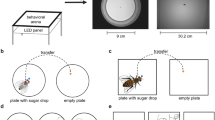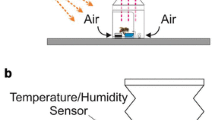Abstract
Honeybees were trained to visit artificial feeding sites containing a 2 mol·1-1 sucrose solution. To reach the feeder they either had to walk through 3 m of Teflon tube, or fly 20 m or 65 m and then walk through 3 m of tube. Only individuals that flew at least 65 m performed waggle dances. The distance indicated in these waggle dances, judged by the number of wagging movements per wagrun, was the same regardless of whether individuals had to run an additional 3 m of tube after flight or not. The energy needed during walking after flight was determined by measuring O2 consumption. All individuals attempted to regulate their body temperatures between 36 and 42°C during walking and feeding (O2 consumption=40μl·min-1 per bee). Calculations show that this walking through 3 m of tube requires as much energy as flying 128 m (difference between thoracic and ambient temperature=15°C). This energy expenditure was not reflected in the dances. The results do not support the hypothesis that honeybees estimate feeding site distances by measuring the energy required to reach a feeder.
Similar content being viewed by others
Abbreviations
- Ta :
-
ambient temperature
- T b :
-
body temperature
- T th :
-
thorax temperature
References
Bastian J, Esch H (1970) The nervous control of the indirect flight muscles of the honey bee. Z Vergl Physiol 67:307–324
Bisetzky AR (1957) Die Tänze der Bienen nach einem Fussweg zum Futterplatz. Z Vergl Physiol 40:264–288
Esch H, Goller F, Heinrich B (1991) How do bees shiver? Naturwis-senschaften 78:325–328
Frisch K von (1967) The dance language and orientation of bees. Harvard University Press, Cambridge, Massachusetts p 566
Goller F, Esch H (1990) Waggle dances of honeybees: is distance measured through energy expenditure on outward flight? Naturwissenschaften 77:594–595
Goller F, Esch H (1991) Oxygen consumption and flight muscle activity during heating in workers and drones of Apis mellifera J Comp Physiol B 161:61–67
Gonçalves LS (1969) A study of orientation information given by one trained bee by dancing. J Apic Res 8:113–132
Gould JL (1975) Honey bee communication: the dance-language controversy. Dissertation Rockefeller University, New York, p 204
Heran H (1956) Ein Beitrag zur Frage nach der Wahrnehmungs-grundlage der Entfernungsweisung der Bienen. Z Vergl Physiol 38:168–218
Neese V (1988) Die Entfernungsmessung der Sammelbiene Ein energetisches and zugleich sensorisches Problem. In: Nachtigall W (ed) The flying honeybee; aspects of energetics. Biona Report 6, Fischer, Stuttgart, New York, pp 1–15
Rothe U, Nachtigall W (1989) Flight of the honeybee IV. Respiratory quotients and metabolic rates during sitting, walking and flying. J Comp Physiol B 158:739–749
Schifferer G (1952) Über die Entfernungsangabe bei den Tänzen der Bienen. Staatsexamensarbeit, Naturwiss. Fak., Univ. München
Schmaranzer S, Stabentheiner A (1988) Variability of the thermal behavior of honeybees on a feeding place. J Comp Physiol B 158:135–141
Scholze E, Pichler H, Heran H (1964) Zur Entfernungsschätzung der Bienen nach dem Kraftaufwand. Naturwissenschaften 51:69–70
Author information
Authors and Affiliations
Rights and permissions
About this article
Cite this article
Esch, H., Goller, F. & Burns, J.E. Honeybee waggle dances: the “energy hypothesis” and thermoregulatory behavior of foragers. J Comp Physiol B 163, 621–625 (1994). https://doi.org/10.1007/BF00369511
Accepted:
Issue Date:
DOI: https://doi.org/10.1007/BF00369511




